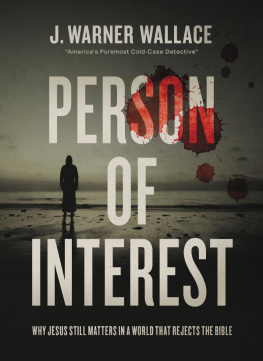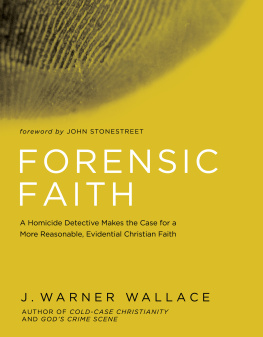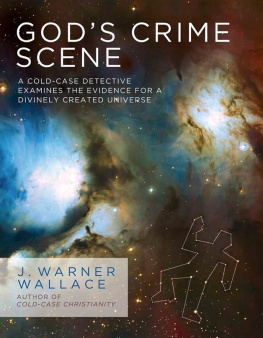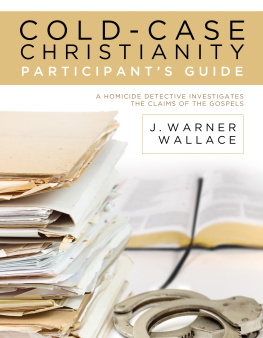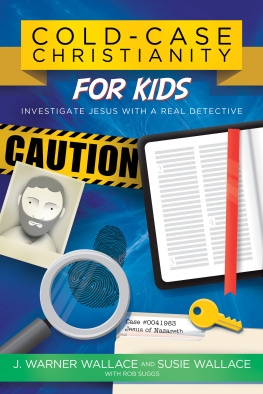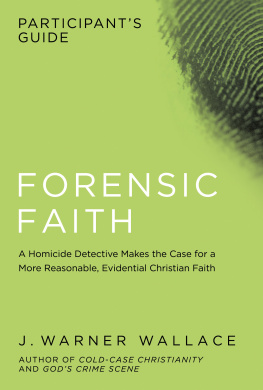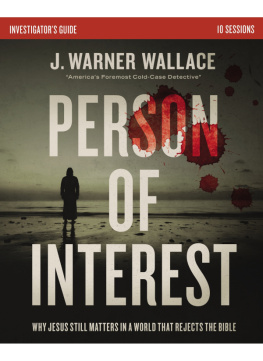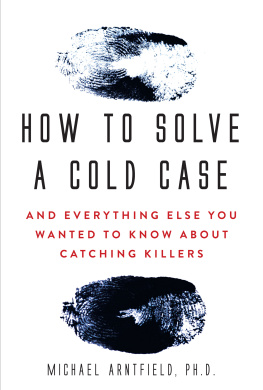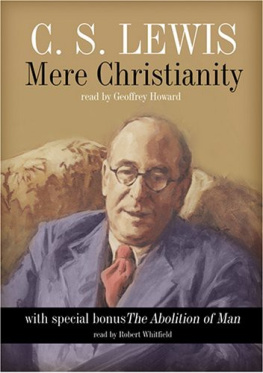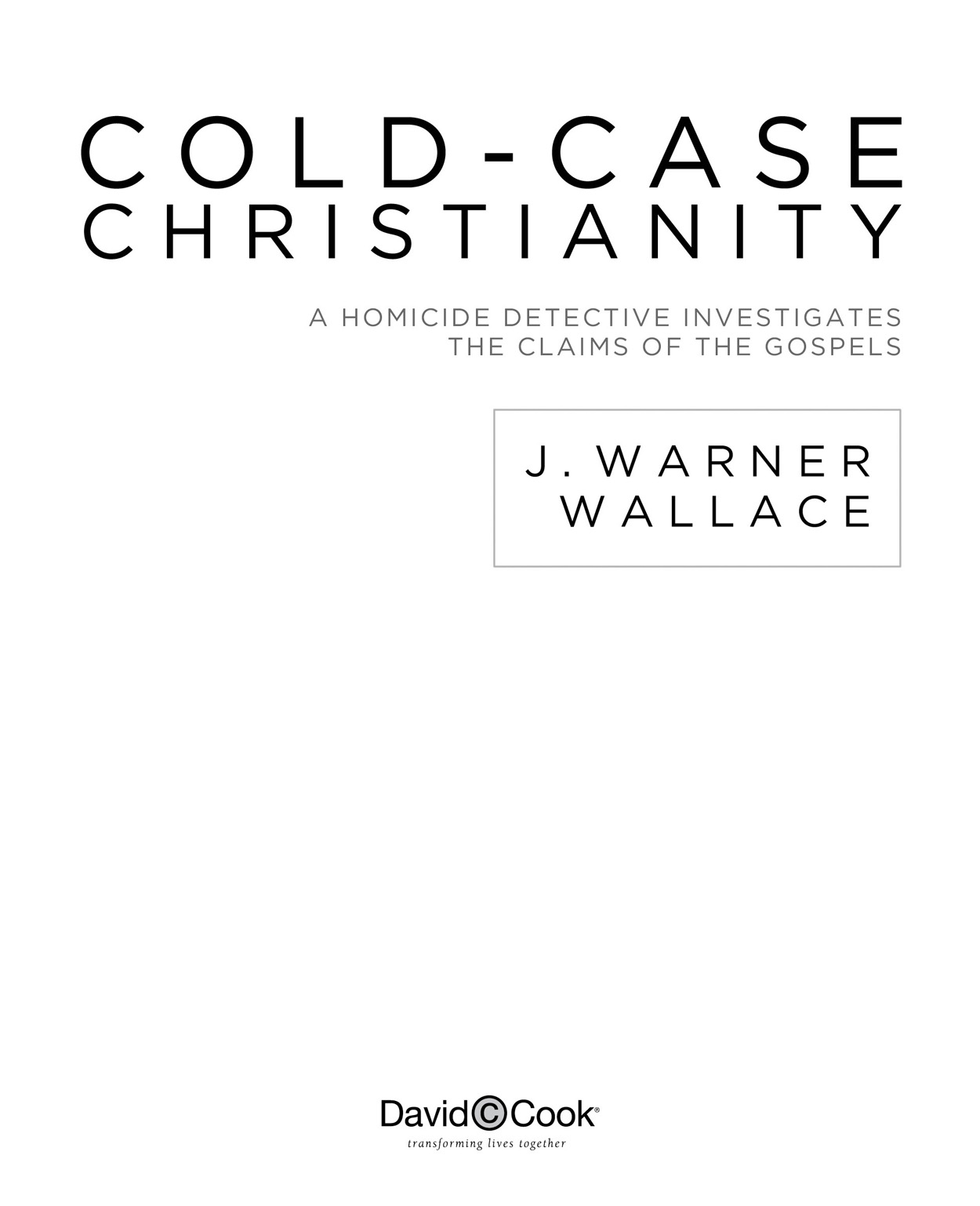
Contents
Chapter 1
Principle #1:
Chapter 2
Principle #2:
Chapter 3
Principle #3:
Chapter 4
Principle #4:
Chapter 5
Principle #5:
Chapter 6
Principle #6:
Chapter 7
Principle #7:
Chapter 8
Principle #8:
Chapter 9
Principle #9:
Chapter 10
Principle #10:
Chapter 11
Chapter 12
Chapter 13
Chapter 14
Case Files
Case Files
Special Thanks:
My deepest thanks to Sean McDowell for motivating me to write this book and for being a true brother in the faith, to Craig Hazen for being the most enthusiastic encourager and connecting me to the people who made the book a reality, to Lee Strobel for having the heart and desire to support this work, and to my literary agent, Mark Sweeney, for answering every phone call and taking a chance with a cold-case detective.
This book is dedicated to my best friend, most trusted partner, and smartest criticmy wife and inspiration, Susie. Thanks for being the first person to read every word and for helping me to be the kind of man who would even dream about writing a book.
Foreword
I loved hanging out with homicide detectives.
I started my journalism career as a general assignment reporter on the overnight shift at the Chicago Tribune , and that meant covering the frequent murders committed around the citycrime-syndicate hits, gang-related violence, domestic disputes gone awry, robberies that got out of hand. Later I was assigned to the criminal courts, where I reported on the major homicide trials from around Cook County.
All of which meant that I spent a lot of time interviewing and socializing with homicide detectives. I liked them because they were no-nonsense, get-to-the-point people, with an uncanny ability to cut through the fog of deception that defendants used to cover their tracks. These street-toughened investigators were seldom fooled by a phony alibi or a flimsy excuse as they systematically unraveled the mysteries that confounded everyone else. They were evidence drivenjust the facts, maam, as the old Jack Webb character in Dragnet used to sayand so was I, constantly checking and rechecking my information before publishing my reports for the city to see.
Back then, I was an atheist. I thought that faith in God was based on conjecture, wishful thinking, and emotions; in fact, the idea that there might be evidence supporting the existence of God was totally alien to me. And I wasnt alone.
J. Warner Wallace is a cold-case homicide investigator who also started out as an outspoken spiritual skeptic. He began with the assumption that the supernatural was impossible. Yet when he diligently applied his skills as a detectiveallowing the evidence to take him wherever it would leadhe came to a far different conclusion. Assessing the evidence with razor-like precision, he solved the most important mystery of all timewhether Jesus of Nazareth is the unique Son of God.
In his savvy and captivating book, Jim will introduce you to the kinds of tools and techniques that he routinely uses to crack unsolved murders that have long baffled other cops. He will show you how this same analytical thinking can be used to crack the case of a long-ago killing on a crossand the incredible resurrection that followed. Its a fascinating process, with Jim drawing on his quarter century of police experience to explain how and why the evidence of history decisively tips the scales in favor of Christianity.
If youre a spiritual skeptic like Jim and I were for many years, then youll find this investigative adventure to be an irresistible, eye-opening, and potentially life-changing journey, full of helpful insights and wisdom. Like a good cop, I hope youll pursue the evidence to the conclusion it ultimately supports. That verdict, in the end, will be yours to reach.
If youre a follower of Jesus, then Jims account will not only bolster your own faith, but also sharpen your skills in explaining to others why so many incisive thinkers throughout history have concluded that Christianity is uniquely credible and trustworthy.
Undoubtedly, youve seen media stories that have traced how cold-case detectives have pieced together an evidential puzzle in order to solve the most perplexing of homicides. Perhaps one of those accounts was based on a case that Jim actually helped crack. But as important as these investigations are, none of them approach the significance of the case that this book tackles.
So get ready to shadow Jim as he probes the evidence for faith. Youll find his approach to be compelling, his logic to be sound, and his conclusions to be amply supported. Unravel with him the historical case for Jesusand discover its eternal implications for you and all the people you know.
Lee Strobel
www.LeeStrobel.com
author of The Case for Christ and The Case for Faith
Preface
THE DETECTIVE WAY
I got the call at about 1:00 a.m. Detectives who are assigned to the homicide unit also investigate officer-involved shootings (OISs), and all of us on the OIS team were called out for this one. When I arrived at the scene, Officer Mark Walker was standing by his patrol car, talking with a sergeant, and waiting for our arrival. I shook his hand, made sure he was ready to talk about the shooting, and began to walk through the events that precipitated our callout.
Mark told me that he was working patrol when he saw a man driving down the street, swerving from lane to lane as though he was drunk. He pulled the driver over and approached his car. When he leaned in to talk to the man, he could smell the alcohol on his breath. Mark asked the man to step out from the car, and the driver reluctantly complied. As the man stood outside his car, Mark could see that he was angry and defiant. Mark decided to conduct a quick pat-down search to make sure the irritated driver wasnt carrying any weapons. Mark had no idea that the driver was Jacob Stevens, a parolee with a long arrest record in an adjacent city. Jacob had just been released from state prison. He was on parole for an assault charge, and tonight he was carrying a loaded Colt .45-caliber pistol hidden in his waistband. Jacob knew that he would go back to jail if the gun was discovered, and he was determined to stay out of jail.
When Mark asked Jacob Stevens to turn around so he could conduct the pat-down search, Jacob turned away for a moment, pulled his gun, and then turned back toward Mark, pointing the gun at Marks chest.
I knew that he had the drop on me, Mark told me as he recalled the events. His gun was already drawn and pointed at me before I could even get my hand on mine.
Jacob had no intention of discussing the situation with Mark. Hed already decided that he wasnt going back to jail, even if it meant killing this police officer. Jacob pointed his gun at Mark and started to squeeze the trigger. Mark was about to enter the fight of his life, and he was starting off with a distinct disadvantage; he was already seconds behind his opponent.
All of us who work in law enforcement understand the importance of wearing our bulletproof vests. When we first became officers, we were trained with these vests, and at some point most of us were shown how the vests performed in live-fire tests. We knew that they could stop a bullet, including a .45 round. On this night, Mark was going to put his vest to the test.
I just tensed my stomach muscles and prepared to take the shot as I pulled my gun out of the holster. I knew he was going to get the first round off.
While Mark knew that his vest could sustain the impact of a .45-caliber round, tonight he trusted in the vest for the very first time. In that singular moment, Mark went from belief that to belief in. Its one thing to believe that the vest can save a life; its another thing to trust it to save your own life. Mark obviously survived the shooting and lived to describe it for us. The lesson I learned from Mark, however, had far more impact on my life than he would ever know.
Next page

